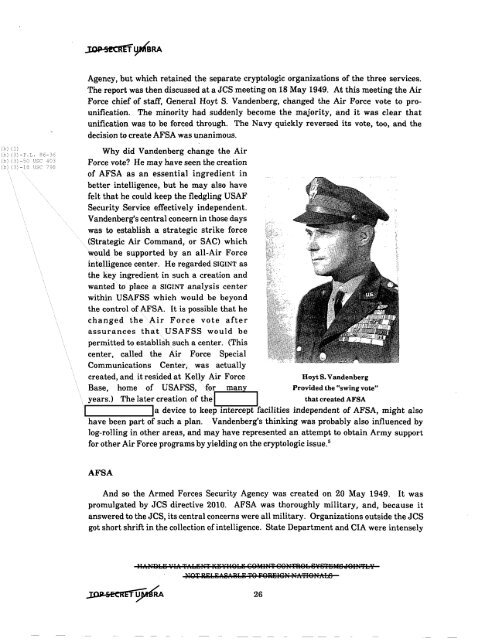American Cryptology during the Cold War - The Black Vault
American Cryptology during the Cold War - The Black Vault
American Cryptology during the Cold War - The Black Vault
You also want an ePaper? Increase the reach of your titles
YUMPU automatically turns print PDFs into web optimized ePapers that Google loves.
Ib) (1)<br />
Ib) (3) -P.L. 86-36<br />
Ib) (3) -50 USC 403<br />
Ib) (3) -18 USC 798<br />
Agency, but which retained <strong>the</strong> separate cryptologic organizations of <strong>the</strong> three services.<br />
<strong>The</strong> report was <strong>the</strong>n discussed at a JCS meeting on 18 May 1949. At this meeting <strong>the</strong> Air<br />
Force chief of staff, General Hoyt S. Vandenberg, changed <strong>the</strong> Air Force vote to prounification.<br />
<strong>The</strong> minority had suddenly become <strong>the</strong> majority, and it was clear that<br />
unification was to be forced through. <strong>The</strong> Navy quickly reversed its vote, too, and <strong>the</strong><br />
decision to create AFSA was unanimous.<br />
Why did Vandenberg change <strong>the</strong> Air<br />
Force vote? He may have seen <strong>the</strong> creation<br />
of AFSA as an essential ingredient in<br />
better intelligence, but he may also have<br />
felt that he could keep <strong>the</strong> fledgling USAF<br />
Security Service effectively independent.<br />
Vandenberg's central concern in those days<br />
was to establish a strategic strike force<br />
(Strategic Air Command, or SAC) which<br />
would be supported by an all-Air Force<br />
intelligence center. He regarded SIGINT as<br />
<strong>the</strong> key ingredient in such a creation and<br />
wanted to place a SIGINT analysis center<br />
within USAFSS which would be beyond<br />
<strong>the</strong> control ofAFSA. It is possible that he<br />
changed <strong>the</strong> Air Force vote after<br />
assurances that USAFSS would be<br />
permitted to establish such a center. (This<br />
center, called <strong>the</strong> Air Force Special<br />
Communications Center;. was actually<br />
created, and it resided at Kelly Air Force<br />
Hoyt S. Vandenberg<br />
Base, home of USAFSS, for many Provided <strong>the</strong> "swing vote"<br />
years.) <strong>The</strong> later creation of <strong>the</strong>l I that created AFSA<br />
la device to keep intercept facilities independent of AFSA, might also<br />
have been part of such a plan. Vandenberg's thinking was probably also influenced by<br />
log-rolling in o<strong>the</strong>r areas, and may have represented an attempt to obtain Army support<br />
for o<strong>the</strong>r Air Force programs by yielding on <strong>the</strong> cryptologic issue. 5<br />
I<br />
AFSA<br />
And so <strong>the</strong> Armed Forces Security Agency was created on 20 May 1949. It was<br />
promulgated by JCS directive 2010. AFSA was thoroughly military, and, because it<br />
answered to <strong>the</strong> JCS, its central concernswere all military. Organizations outside <strong>the</strong> JCS<br />
got short shrift in <strong>the</strong> collection ofintelligence. State Department and CIA were intensely<br />
ILurabS VI"'l'AbS~rl'l'fSYIlQU SQMUTl' SQ~rl'aQb 8Y8l'SMS dQUTl'bY<br />
MQT KiU 1\~"'RbiTQ FQaSIS~r ~rAl'IQPiAb6<br />
26
















